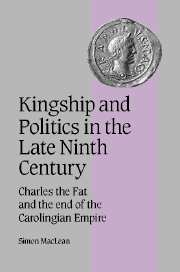 Kingship and Politics in the Late Ninth Century
Kingship and Politics in the Late Ninth Century Book contents
- Frontmatter
- Contents
- List of maps and figures
- Acknowledgements
- List of abbreviations
- Note on names, terminology and citations
- Outline chronology
- Figure 1 The Carolingian family
- Map 1 The late Carolingian empire
- 1 INTRODUCTION
- 2 UN-FRANKISH ACTIVITIES: CHARLES THE FAT IN THE EYES OF CONTEMPORARY ANNALISTS
- 3 THE MEN WHO WOULD BE KINGS: THE ‘SUPERMAGNATES’ AND THE ‘RISE OF THE ARISTOCRACY’
- 4 ROYAL POLITICS AND REGIONAL POWER IN THE LATE CAROLINGIAN EMPIRE
- 5 THE END OF THE EMPIRE I: POLITICS AND IDEOLOGY AT THE EAST FRANKISH COURT
- 6 THE END OF THE EMPIRE II: RESPONSE AND FAILURE
- 7 HISTORY, POLITICS AND THE END OF THE EMPIRE IN NOTKER'S DEEDS OF CHARLEMAGNE
- 8 CONCLUSION
- Bibliography
- Index
- Cambridge Studies in Medieval Life and Thought Fourth Series
7 - HISTORY, POLITICS AND THE END OF THE EMPIRE IN NOTKER'S DEEDS OF CHARLEMAGNE
Published online by Cambridge University Press: 15 July 2009
- Frontmatter
- Contents
- List of maps and figures
- Acknowledgements
- List of abbreviations
- Note on names, terminology and citations
- Outline chronology
- Figure 1 The Carolingian family
- Map 1 The late Carolingian empire
- 1 INTRODUCTION
- 2 UN-FRANKISH ACTIVITIES: CHARLES THE FAT IN THE EYES OF CONTEMPORARY ANNALISTS
- 3 THE MEN WHO WOULD BE KINGS: THE ‘SUPERMAGNATES’ AND THE ‘RISE OF THE ARISTOCRACY’
- 4 ROYAL POLITICS AND REGIONAL POWER IN THE LATE CAROLINGIAN EMPIRE
- 5 THE END OF THE EMPIRE I: POLITICS AND IDEOLOGY AT THE EAST FRANKISH COURT
- 6 THE END OF THE EMPIRE II: RESPONSE AND FAILURE
- 7 HISTORY, POLITICS AND THE END OF THE EMPIRE IN NOTKER'S DEEDS OF CHARLEMAGNE
- 8 CONCLUSION
- Bibliography
- Index
- Cambridge Studies in Medieval Life and Thought Fourth Series
Summary
The events of the mid to late 880s were, as we have seen, crucial for understanding the nature of the crisis of Charles the Fat's reign in particular and of Carolingian political hegemony more generally. In order to find some further reflection of how contemporaries, and in particular members of the imperial court, understood these events, we have at our disposal a text which stands among the major historical works of the whole period, namely the Deeds of Charlemagne (Gesta Karoli – the title is not contemporary) by Notker the Stammerer, a monk of St-Gall. Earlier generations of historians looked unfavourably upon Notker's anecdotal, humorous, moralising and, by positivist standards, historically inaccurate approach, dismissing it as a laughably gauche imitation of the more stately Carolingian biographies penned by Einhard, Thegan and the Astronomer. Louis Halphen summed up this evaluation when he colourfully pronounced that Notker's Deeds was as useful a source for the reign of Charlemagne as was Dumas's The Three Musketeers for that of Louis XIII. Recent commentators have been more sympathetic, coming at the Deeds from different angles. In particular, David Ganz has shown that the very mangling of historical sources which Halphen saw as the most reprehensible aspect of the Deeds is in fact its central structural element.
- Type
- Chapter
- Information
- Kingship and Politics in the Late Ninth CenturyCharles the Fat and the End of the Carolingian Empire, pp. 199 - 229Publisher: Cambridge University PressPrint publication year: 2003
- 1
- Cited by
